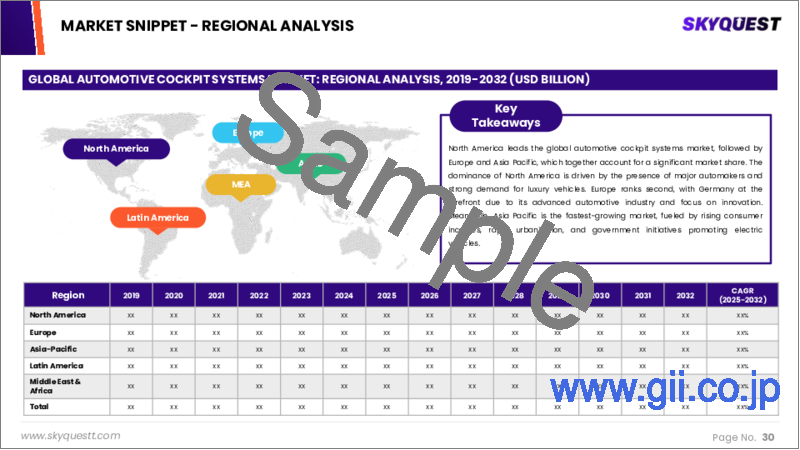|
|
市場調査レポート
商品コード
1628971
自動車コックピットシステム市場規模、シェア、成長分析、装置別、車両タイプ別、電気自動車別、地域別 - 産業予測、2025-2032年Automotive Cockpit Systems Market Size, Share, Growth Analysis, By Equipment (Digital Instrument Cluster, Advanced Head Unit), By Vehicle Type (Passenger Vehicle, Commercial Vehicle), By Electric Vehicle, By Region - Industry Forecast 2025-2032 |
||||||
|
|||||||
| 自動車コックピットシステム市場規模、シェア、成長分析、装置別、車両タイプ別、電気自動車別、地域別 - 産業予測、2025-2032年 |
|
出版日: 2025年01月06日
発行: SkyQuest
ページ情報: 英文 271 Pages
納期: 3~5営業日
|
全表示
- 概要
- 目次
自動車コックピットシステムの世界市場規模は2023年に332億米ドルと評価され、2024年の376億8,000万米ドルから2032年には1,037億8,000万米ドルに成長し、予測期間中(2025-2032年)のCAGRは13.5%で成長する見通しです。
世界の自動車市場は、車載テレマティクス、エンターテインメント・システム、先進安全センサーの採用増加や、モノのインターネットの影響力の拡大に後押しされ、力強い成長を遂げています。この成長は、新興国市場と先進国市場の両方において、快適性、安全性、利便性の向上を求める消費者の需要が原動力となっています。高級車セグメントと自律走行技術の台頭が市場の可能性をさらに高めています。コックピット・システムの進歩は、従来のアナログ・ディスプレイの限界に対処し、複数のスクリーン、デジタル・アシスタント、適応可能な入力方法を組み込んだデジタル体験を提供しています。2022年までには、乗用車の90%以上が3G/4G接続を利用するようになると予想されます。VolkswagenやAudiといった大手自動車メーカーの製品に代表されるデジタル・コックピットの人気は、技術革新と市場拡大の大きなチャンスを約束しています。
目次
イントロダクション
- 調査の目的
- 調査範囲
- 定義
調査手法
- 情報調達
- 二次データと一次データの方法
- 市場規模予測
- 市場の前提条件と制限
エグゼクティブサマリー
- 世界市場の見通し
- 供給と需要の動向分析
- セグメント別機会分析
市場力学と見通し
- 市場概要
- 市場規模
- 市場力学
- 促進要因と機会
- 抑制要因と課題
- ポーターの分析
主な市場の考察
- 重要成功要因
- 競合の程度
- 主な投資機会
- 市場エコシステム
- 市場の魅力指数(2024年)
- PESTEL分析
- マクロ経済指標
- バリューチェーン分析
- 価格分析
- 技術分析
- 規制分析
- 特許分析
- ケーススタディ
自動車コックピットシステム市場規模:装置別
- 市場概要
- デジタル計器クラスター
- 高度なヘッドユニット
- ヘッドアップディスプレイ(HUD)
- カメラベースのドライバーモニタリングシステム
自動車コックピットシステム市場規模:車両タイプ別
- 市場概要
- 乗用車
- 商用車
自動車コックピットシステム市場規模:電気自動車別
- 市場概要
- バッテリー電気自動車(BEV)
- ハイブリッド電気自動車(HEV)
- プラグインハイブリッド電気自動車(PHEV)
自動車コックピットシステム市場規模
- 北米
- 米国
- カナダ
- 欧州
- ドイツ
- スペイン
- フランス
- 英国
- イタリア
- その他欧州地域
- アジア太平洋地域
- 中国
- インド
- 日本
- 韓国
- その他アジア太平洋地域
- ラテンアメリカ
- ブラジル
- その他ラテンアメリカ地域
- 中東・アフリカ
- GCC諸国
- 南アフリカ
- その他中東・アフリカ
競合情報
- 上位5社の比較
- 主要企業の市場ポジショニング(2024年)
- 主な市場企業が採用した戦略
- 市場の最近の動向
- 企業の市場シェア分析(2024年)
- 主要企業の企業プロファイル
- 会社概要
- 製品ポートフォリオ分析
- セグメント別シェア分析
- 収益の前年比比較(2022-2024)
主要企業プロファイル
- Robert Bosch GmbH(Germany)
- Continental AG(Germany)
- Denso Corporation(Japan)
- Visteon(US)
- Panasonic(Japan)
- Hyundai Mobis(South Korea)
- Garmin(US)
- Nippon(Japan)
- Faurecia(France)
- Aptiv(US)
- Pioneer(Japan)
- Magneti Marelli(Italy)
- Valeo(France)
- Clarion(Japan)
- Calsonic Kansei Corporation(Japan)
- Wayray(Switzerland)
- Preh(Germany)
- Desay SV(China)
- Yazaki(Japan)
- Luxoft(Switzerland)
結論と推奨事項
Global Automotive Cockpit Systems Market size was valued at USD 33.2 billion in 2023 and is poised to grow from USD 37.68 billion in 2024 to USD 103.78 billion by 2032, growing at a CAGR of 13.5% during the forecast period (2025-2032).
The global automotive market is experiencing robust growth, fueled by increasing adoption of in-vehicle telematics, entertainment systems, and advanced safety sensors, as well as the growing influence of the Internet of Things. This growth is driven by consumer demand for enhanced comfort, safety, and convenience across both emerging and developed markets. The luxury vehicle segment and the rise of autonomous technologies further elevate market potential. Advances in cockpit systems are addressing the limitations of traditional analogue displays, offering digital experiences that incorporate multiple screens, digital assistants, and adaptable input methods. By 2022, over 90% of passenger cars are expected to leverage 3G/4G connectivity. The popularity of digital cockpits, exemplified by offerings from major automakers like Volkswagen and Audi, promises significant opportunities for innovation and market expansion.
Top-down and bottom-up approaches were used to estimate and validate the size of the Global Automotive Cockpit Systems market and to estimate the size of various other dependent submarkets. The research methodology used to estimate the market size includes the following details: The key players in the market were identified through secondary research, and their market shares in the respective regions were determined through primary and secondary research. This entire procedure includes the study of the annual and financial reports of the top market players and extensive interviews for key insights from industry leaders such as CEOs, VPs, directors, and marketing executives. All percentage shares split, and breakdowns were determined using secondary sources and verified through Primary sources. All possible parameters that affect the markets covered in this research study have been accounted for, viewed in extensive detail, verified through primary research, and analyzed to get the final quantitative and qualitative data.
Global Automotive Cockpit Systems Market Segmental Analysis
Global Automotive Cockpit Systems Market is segmented by Equipment, Vehicle Type, Electric Vehicle and region. Based on Equipment, the market is segmented into Digital Instrument Cluster, Advanced Head Unit, Head-Up Display (HUD) and Camera-Based Driver Monitoring System. Based on Vehicle Type, the market is segmented into Passenger Vehicle and Commercial Vehicle. Based on Electric Vehicle, the market is segmented into Battery Electric Vehicle (BEV), Hybrid Electric Vehicle (HEV) and Plug-In Hybrid Electric Vehicle (PHEV). Based on region, the market is segmented into North America, Europe, Asia Pacific, Latin America and Middle East & Africa.
Driver of the Global Automotive Cockpit Systems Market
The Global Automotive Cockpit Systems market is being significantly propelled by the increasing demand for advanced safety features within vehicles. As consumer preferences shift towards enhanced safety technologies, automakers are under pressure to integrate sophisticated cockpit systems that prioritize driver and passenger well-being. This necessity for innovation is driving manufacturers to develop versatile and high-performance cockpit solutions that include features such as advanced driver-assistance systems, improved ergonomic designs, and intuitive user interfaces. Consequently, the pursuit of safety and technological advancements is a crucial factor in the growth and evolution of the automotive cockpit systems market worldwide.
Restraints in the Global Automotive Cockpit Systems Market
The Global Automotive Cockpit Systems market faces significant constraints related to security concerns. The integration of digital cockpits with internet connectivity and various devices heightens the risk of cyberattacks and hacking incidents, which could compromise the safety and security of both drivers and passengers. As vehicles become more technologically advanced, the potential for cyber threats increases, raising alarms regarding the reliability of these systems. This vulnerability may deter consumers from embracing advanced cockpit technologies, ultimately impacting the market's growth and innovation potential. Addressing these security issues is crucial for fostering consumer confidence and ensuring the advancement of automotive cockpit solutions.
Market Trends of the Global Automotive Cockpit Systems Market
The Global Automotive Cockpit Systems market is witnessing a significant trend towards the integration of AI and voice assistants within digital cockpits. As consumers demand more intuitive and seamless in-car experiences, manufacturers are increasingly adopting advanced infotainment systems featuring voice control capabilities powered by platforms like Amazon Alexa and Google Assistant. This evolution not only enhances user interaction with the vehicle's various features but also aligns with the broader shift towards automation and connectivity in the automotive industry. Consequently, the demand for sophisticated cockpit systems is accelerating, driving innovation and competition among automotive manufacturers to create smarter, more user-friendly vehicle interiors.
Table of Contents
Introduction
- Objectives of the Study
- Scope of the Report
- Definitions
Research Methodology
- Information Procurement
- Secondary & Primary Data Methods
- Market Size Estimation
- Market Assumptions & Limitations
Executive Summary
- Global Market Outlook
- Supply & Demand Trend Analysis
- Segmental Opportunity Analysis
Market Dynamics & Outlook
- Market Overview
- Market Size
- Market Dynamics
- Drivers & Opportunities
- Restraints & Challenges
- Porters Analysis
- Competitive rivalry
- Threat of substitute
- Bargaining power of buyers
- Threat of new entrants
- Bargaining power of suppliers
Key Market Insights
- Key Success Factors
- Degree of Competition
- Top Investment Pockets
- Market Ecosystem
- Market Attractiveness Index, 2024
- PESTEL Analysis
- Macro-Economic Indicators
- Value Chain Analysis
- Pricing Analysis
- Technology Analysis
- Regulatory Analysis
- Patent Analysis
- Case Studies
Global Automotive Cockpit Systems Market Size by Equipment & CAGR (2025-2032)
- Market Overview
- Digital Instrument Cluster
- Advanced Head Unit
- Head-Up Display (HUD)
- Camera-Based Driver Monitoring System
Global Automotive Cockpit Systems Market Size by Vehicle Type & CAGR (2025-2032)
- Market Overview
- Passenger Vehicle
- Commercial Vehicle
Global Automotive Cockpit Systems Market Size by Electric Vehicle & CAGR (2025-2032)
- Market Overview
- Battery Electric Vehicle (BEV)
- Hybrid Electric Vehicle (HEV)
- Plug-In Hybrid Electric Vehicle (PHEV)
Global Automotive Cockpit Systems Market Size & CAGR (2025-2032)
- North America (Equipment, Vehicle Type, Electric Vehicle)
- US
- Canada
- Europe (Equipment, Vehicle Type, Electric Vehicle)
- Germany
- Spain
- France
- UK
- Italy
- Rest of Europe
- Asia Pacific (Equipment, Vehicle Type, Electric Vehicle)
- China
- India
- Japan
- South Korea
- Rest of Asia-Pacific
- Latin America (Equipment, Vehicle Type, Electric Vehicle)
- Brazil
- Rest of Latin America
- Middle East & Africa (Equipment, Vehicle Type, Electric Vehicle)
- GCC Countries
- South Africa
- Rest of Middle East & Africa
Competitive Intelligence
- Top 5 Player Comparison
- Market Positioning of Key Players, 2024
- Strategies Adopted by Key Market Players
- Recent Developments in the Market
- Company Market Share Analysis, 2024
- Company Profiles of All Key Players
- Company Details
- Product Portfolio Analysis
- Company's Segmental Share Analysis
- Revenue Y-O-Y Comparison (2022-2024)
Key Company Profiles
- Robert Bosch GmbH (Germany)
- Company Overview
- Business Segment Overview
- Financial Updates
- Key Developments
- Continental AG (Germany)
- Company Overview
- Business Segment Overview
- Financial Updates
- Key Developments
- Denso Corporation (Japan)
- Company Overview
- Business Segment Overview
- Financial Updates
- Key Developments
- Visteon (US)
- Company Overview
- Business Segment Overview
- Financial Updates
- Key Developments
- Panasonic (Japan)
- Company Overview
- Business Segment Overview
- Financial Updates
- Key Developments
- Hyundai Mobis (South Korea)
- Company Overview
- Business Segment Overview
- Financial Updates
- Key Developments
- Garmin (US)
- Company Overview
- Business Segment Overview
- Financial Updates
- Key Developments
- Nippon (Japan)
- Company Overview
- Business Segment Overview
- Financial Updates
- Key Developments
- Faurecia (France)
- Company Overview
- Business Segment Overview
- Financial Updates
- Key Developments
- Aptiv (US)
- Company Overview
- Business Segment Overview
- Financial Updates
- Key Developments
- Pioneer (Japan)
- Company Overview
- Business Segment Overview
- Financial Updates
- Key Developments
- Magneti Marelli (Italy)
- Company Overview
- Business Segment Overview
- Financial Updates
- Key Developments
- Valeo (France)
- Company Overview
- Business Segment Overview
- Financial Updates
- Key Developments
- Clarion (Japan)
- Company Overview
- Business Segment Overview
- Financial Updates
- Key Developments
- Calsonic Kansei Corporation (Japan)
- Company Overview
- Business Segment Overview
- Financial Updates
- Key Developments
- Wayray (Switzerland)
- Company Overview
- Business Segment Overview
- Financial Updates
- Key Developments
- Preh (Germany)
- Company Overview
- Business Segment Overview
- Financial Updates
- Key Developments
- Desay SV (China)
- Company Overview
- Business Segment Overview
- Financial Updates
- Key Developments
- Yazaki (Japan)
- Company Overview
- Business Segment Overview
- Financial Updates
- Key Developments
- Luxoft (Switzerland)
- Company Overview
- Business Segment Overview
- Financial Updates
- Key Developments





